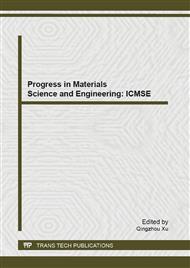p.547
p.552
p.558
p.567
p.574
p.579
p.584
p.588
p.594
Effect of Preparation Conditions on the Performance of Ni-TiB2-Gd2O3 Composite Coatings
Abstract:
TiB2 and Gd2O3 were used as codeposited particles for the first time in preparing Ni-TiB2-Gd2O3 composite coatings to improve its performance. Ni-TiB2-Gd2O3 composite coatings were prepared by electrodeposition method from a nickel cetyltrimethylammonium bromide and hexadecylpyridinium bromide solution containing TiB2 and Gd2O3 particles. The content of codeposited TiB2 and Gd2O3 in the composite coatings was controlled by the addition of different TiB2 and Gd2O3 particles concentrations in the solution, respectively. The effects of TiB2 and Gd2O3 content on microhardness, wear weight loss, and friction coefficient of composite coatings were investigated, respectively. Ni-TiB2-Gd2O3 composite coatings shows higher microhardness and lower wear weight loss, friction coefficient than those of the pure Ni coating and Ni-TiB2 composite coatings. The wear weight loss of Ni-TiB2-Gd2O3 composite coatings is lower 9.13 and 1.59 times than that of the pure Ni coating and Ni-TiB2 composite coatings, respectively. The friction coefficients of pure Ni coating, Ni-TiB2 and Ni-TiB2-Gd2O3 composite coatings are 0.723, 0.815 and 0.43, respectively. Ni-TiB2-Gd2O3 composite coatings shows the least friction coefficient among the three coatings. Gd2O3 particles in composite coatings serves as solid lubricant between contact surfaces, decreases the friction coefficient, abates the wear and increases the corrosion resistance of the composite coatings. The loading-bearing capacity and the wear-reducing effect of the Gd2O3 particles in the composite coatings are closely related to the content of Gd2O3 particles in the composite coatings.
Info:
Periodical:
Pages:
574-578
Citation:
Online since:
October 2013
Authors:
Keywords:
Price:
Сopyright:
© 2013 Trans Tech Publications Ltd. All Rights Reserved
Share:
Citation:


